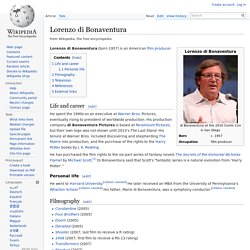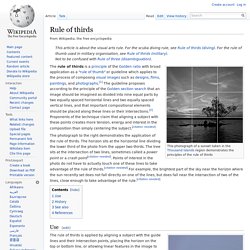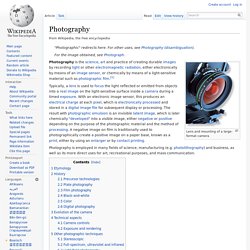

Lorenzo di Bonaventura. Lorenzo di Bonaventura (born 1957) is an American film producer.

Life and career[edit] Personal life[edit] He went to Harvard University. [citation needed] He later received an MBA from the University of Pennsylvania's Wharton School. Rule of thirds. This photograph of a sunset taken in the Thousand Islands region demonstrates the principles of the rule of thirds The rule of thirds is a principle of the Golden ratio with broad application as a "rule of thumb" or guideline which applies to the process of composing visual images such as designs, films, paintings, and photographs.[1] The guideline proposes according to the principle of the Golden section search that an image should be imagined as divided into nine equal parts by two equally spaced horizontal lines and two equally spaced vertical lines, and that important compositional elements should be placed along these lines or their intersections.[2] Proponents of the technique claim that aligning a subject with these points creates more tension, energy and interest in the composition than simply centering the subject.

[citation needed] The photograph to the right demonstrates the application of the rule of thirds. Category:Photo sharing. Photographic print toning. A sepia-toned photograph taken in England in 1895 Aerial view of downtown Houston 1977 A digitally sepia-toned image taken in 2007 In photography, toning is a method of changing the color of black-and-white photographs.

In analog photography, toning is a chemical process carried out on silver-based photographic prints. This darkroom process can not be done with a color photograph. Portal:Photography. Photography. For the image obtained, see Photograph.

Lens and mounting of a large-format camera Photography is the science, art and practice of creating durable images by recording light or other electromagnetic radiation, either electronically by means of an image sensor, or chemically by means of a light-sensitive material such as photographic film.[1] Photography is employed in many fields of science, manufacturing (e.g. photolithography) and business, as well as its more direct uses for art, recreational purposes, and mass communication. Etymology[edit] The word "photography" was created from the Greek roots φωτός (phōtos), genitive of φῶς (phōs), "light"[2] and γραφή (graphé) "representation by means of lines" or "drawing",[3] together meaning "drawing with light".
Several people may have coined the same new term from these roots independently. History[edit] Precursor technologies[edit] A camera obscura used for drawing images Photography is the result of combining several technical discoveries. Photographie. Un article de Wikipédia, l'encyclopédie libre.

La photographie[1] est une technique qui permet de créer des images par l'action de la lumière. La photographie désigne aussi l'image obtenue. Le terme photographie désigne également la branche des arts graphiques qui utilise cette technique : c'est l'« écriture de la lumière ». Étymologie Le mot « photographie » a été imaginé par John Herschel et provient de deux racines d'origine grecque : le préfixe « photo- » (φωτoς, photos : lumière, clarté) — qui procède de la lumière, qui utilise la lumière ;le suffixe « -graphie » (γραφειν, graphein : peindre, dessiner, écrire) — qui écrit, qui aboutit à une image. Littéralement : « peindre avec la lumière ». La personne utilisant la technique photographique lors de la phase de prise de vue se nomme le photographe. Martin Schoeller. International Center of Photography, New York Martin Schoeller (born March 12, 1968) is a New York-based photographer whose style of "hyper-detailed close ups" is distinguished by similar treatment of all subjects whether they are celebrities or unknown.

His most recognizable work are his portraits, shot with similar lighting, backdrop, and tone. His work appears in "National Geographic Magazine", The New Yorker, "New York Time Magazine", Time, GQ, and Vogue.[1] He has been a staff photographer at The New Yorker since 1999.[2] Balance des blancs. Un article de Wikipédia, l'encyclopédie libre.

Pour les articles homonymes, voir balance. Category:Photography. Category:Works about photography. Category:Photography websites. Annie Leibovitz. Shutter speed. Shutter speed can have a dramatic impact on the appearance of moving objects.

Changes in background blurring are apparent as exposure time increases. Slow shutter speed combined with panning the camera can achieve a motion blur for moving objects. Introduction[edit] Multiple combinations of shutter speed and f-number can give the same exposure value. According to exposure value formula, doubling the exposure time doubles the amount of light (subtracts 1 EV). ) also doubles the amount of light. In addition to its effect on exposure, the shutter speed changes the way movement appears in photographs.
Adjustment to the aperture controls the depth of field, the distance range over which objects are acceptably sharp; such adjustments need to be compensated by changes in the shutter speed. In early days of photography, available shutter speeds were not standardized, though a typical sequence might have been 1/10 s, 1/25 s, 1/50 s, 1/100 s, 1/200 s and 1/500 s. Main article: Motion blur.